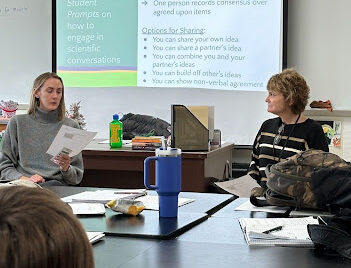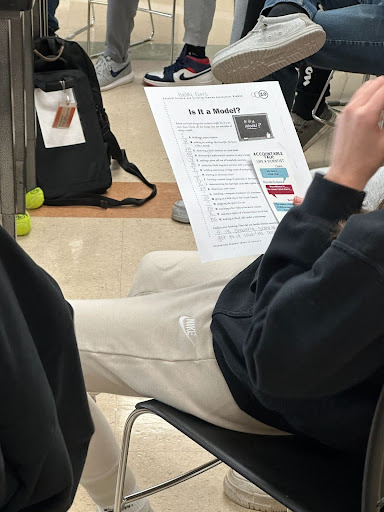At Washington High School in Washington, IA, Science Consultant Maria Hasken-Averkamp collaborated with high school science teachers to help model a piece of OpenSciEd’ s curriculum, "the Scientist Circle." In this innovative science education model, students don't just learn — they collaborate, communicate, and build a vibrant community of learners, mirroring the collaborative spirit of real-world scientists.
The Essence of Scientist Circles — Embracing Collaboration
At the heart of Scientist Circles is the philosophy of "Figuring it out together." This collaborative spirit transforms the learning space, with students arranged in a circle that facilitates direct communication and visibility among peers.
The emphasis is on creating a space for students to engage in meaningful conversations about the concepts they are exploring. The journey is not solitary; it's a collective effort. Students work towards reaching a consensus on the ideas they uncover, mirroring the real-world practice of collaborative scientific endeavors.
Science and Engineering Practices in Focus
The Scientist Circle method emphasizes specific science and engineering practices, including:
- Developing and using models: Students actively engage in creating and utilizing models to enhance their understanding.
- Engaging in argument from evidence and reasoning: Encouraging students to support their ideas with evidence and logical reasoning, fostering a deeper understanding of scientific concepts.
Nurturing Accountable Talk
In the Scientist Circle, accountable talk is the cornerstone for appropriate and fruitful conversations. Establishing norms becomes crucial for maintaining a healthy and productive circle. Some notable norms include:
- Critique ideas, not people: Creating an environment where ideas are open for discussion without personal criticism.
- Encourage every voice: Providing space for all students to contribute, particularly those whose voices may not have been heard.
- Respecting silence: Acknowledging the importance of giving individuals the space to express their thoughts.
| Before engaging in the Scientist Circle, students participated in a prethink activity to help provide all students with background and experience to support their participation in the discussion. This prompt came from Page Keeley’s Understanding Student Science Ideas called, Is it A Model? To encourage participation, students are provided with bookmarks and sentence stems, guiding them to contribute thoughtfully to the ongoing conversation. Bookmarks can be printed off for free using this document. |  |
Unveiling the "Why"
The Scientist Circle method delves into the "why" behind scientific phenomena, moving beyond surface-level memorization. Students actively engage in understanding the underlying reasons behind concepts, fostering a more profound connection with the subject matter. As students practiced making claims with evidence and reasoning to build a class consensus about what elements they felt were important in scientific models. This is an example of how students learn to move scientific thinking forward by practicing science discourse.
Insights from the Teacher's Perspective
Scientist Circle is one element of the OpenSciEd curriculum. Washington High School Teachers have taken on OpenSciEd’s curriculum, which offers a unique perspective from traditional high school science classes. OpenSciEd curriculum is phenomena-based and centers on student-led questioning, investigating, and problem-solving, with teachers supporting students as learning facilitators rather than lecturers. In the high school OpenSciEd sequence, students begin by taking Biology, then Chemistry, and then Physics. Earth and space science is integrated throughout those three courses. All the NGSS performance expectations, including the engineering standards, are included in the three-year science sequence.
Teacher Terryl Brandy added, “Students are getting content in a new way. Together students process as a class which branches them out of their comfort zone. I like teaching this way and this is the way my brain works. With OpenSciEd, we are able to pull cutting-edge science into the classroom from the forefront of science and connecting science to real life. Not just learning content for content’s sake”
Teacher Sarah Dawson said, "This is the way I had been wanting to teach. Letting the kids drive the flow of the units and using their questions to make it happen. Students initially had a lack of confidence because they weren’t given the answer by the teacher. Now their ability to ask questions and build models has grown.” Modeling is also a key component of OpenSciEd. “ I can see what they are grasping and what they are struggling with. The models make it easier to see their understanding as opposed to how they used to be assessed through multiple choice questioning,” Sarah explained.
“OpenSciEd mixes together content and skills in just the right way. OpenSciEd puts students at the forefront of problem solving by focusing on an open-ended phenomena designed to spark questioning and thinking. Students' minds aren’t currently geared toward open-ended questioning. The open-endedness of the curriculum has been the most challenging hurdle to overcome in OpenSciEd. The students are accustomed to the plug and chug, question and answer format used in more traditional learning environments,” explained Amy Chown.
Scientist Circle = Discussion Circle
The Scientist Circle emerges as a transformative approach as it not only equips students with essential skills but also nurtures a genuine passion for understanding the scientific world. A Scientist Circle is a path toward nurturing discussion in the classroom. Consider how you can transfer this strategy to other subject areas by exploring this strategy sheet from Grant Wood AEA's Transformative Classrooms Team to increase engagement and student-led agency in all classrooms.
Curious to know more about Scientist Circles or OpenSciEd? Contact your GWAEA Science Consultants.
About the Authors:
This blog post was written by Grant Wood AEA Science Consultant Maria Hasken-Averkamp and Grant Wood AEA Digital Learning Consultant Amber Bridge
